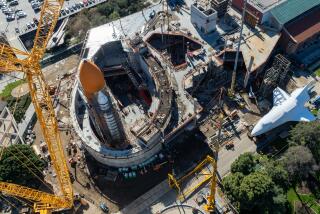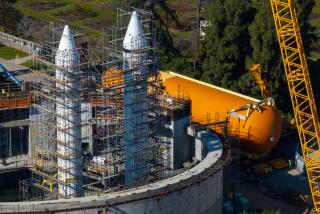Shuttle Lifts Telescope a Bit Closer to Stars
- Share via
JOHNSON SPACE CENTER, Texas — Shuttle Discovery fled to a safer, higher orbit with the Hubble Space Telescope on Saturday to avoid a piece of space junk the size of a book.
The fragment of an exploded rocket would have come dangerously close to Discovery, its seven astronauts and the telescope anchored in the cargo bay had the crew not steered out of the way.
Hours later, Mark Lee and Steven Smith went into open space and replaced one of Hubble’s computerized units with an upgraded model. Lee had to undo, and then redo, 18 electrical connectors, the most hand-intensive work of the three spacewalks to date.
NASA, meanwhile, was considering an emergency face lift for the middle-aged telescope, which has been in space for seven years.
Astronauts making the mission’s second spacewalk Friday night discovered a surprising number of cracks and tears in Hubble’s thin, outer insulation, as well as holes punched into the solar panels by micrometeoroids.
The National Aeronautics and Space Administration formed an investigative team to assess the damage, most of which seems to have occurred since the 1993 repair mission. The astronauts may be asked to patch the foil insulation during their fourth and final spacewalk tonight.
Spacewalk No. 3, on Saturday night, was already crowded with Hubble chores: the installation of a new computer switchboard digital recorder and a flywheel assembly that helps aim the telescope.
Hubble got a bigger boost than planned Saturday.
A few hours after Discovery’s pilots steered the shuttle and the moored Hubble into a 2-mile-higher orbit to extend the lifetime of the telescope, they were ordered to go up an additional half a mile.
An 8-inch-square fragment of an exploded Pegasus rocket was due to pass within half a mile of the shuttle and telescope, officials said, and Mission Control did not want to take any chances. The speed of the debris: 17,500 mph.
The Pegasus was launched in 1994 with a military research satellite, which ended up in the wrong orbit.
Fortunately, boosting Hubble on Saturday was part of NASA’s plan all along.
Like any orbiting object, the telescope gradually loses altitude because of gravity’s constant tug and friction from the outer atmosphere. The astronauts planned to raise Hubble an additional 2 1/2 miles over the next two nights, into a 375-mile-high orbit.
More to Read
Sign up for Essential California
The most important California stories and recommendations in your inbox every morning.
You may occasionally receive promotional content from the Los Angeles Times.













